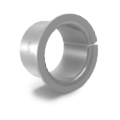What is the difference between seat bushings and seat bushes?
Seat bushes and bushings refer to the same component. Many European companies use the term “bushes” while “bushings” is the preferred term in the US.
Why are seat bushings important?
Seat bushes help to raise and lower headrests and armrests, and recline, elevate and slide the seat position for comfort and safety. The help to facilitate the movement smoothly without noise or vibration.
How are seat bushings constructed?
Since seat bushings are responsible for managing load in differing environmental temperatures, a typical metal backed cylindrical or flanged bushing is constructed in three unique composite layers – a steel back, bronze intermediate layer and PTFE liner. The PTFE helps the bushing generates controlled movement with low friction and optimal wear resistance. It is also important for low NVH.
Why do some bushings have one flange while others have two?
The flange, or extended flat surface at the edge of a bushing, acts as an end stop to prevent the bushing from moving axially. To prevent the bushing from sliding out from its housing, a manufacturer will request a double flange.
How often do seat bushings need to be replaced?
Never! Seat bushings are designed to last the life of the vehicle and more. When they are properly designed, seat manufacturers and end users will experience a comfortable, enjoyable and safe ride for many years.



